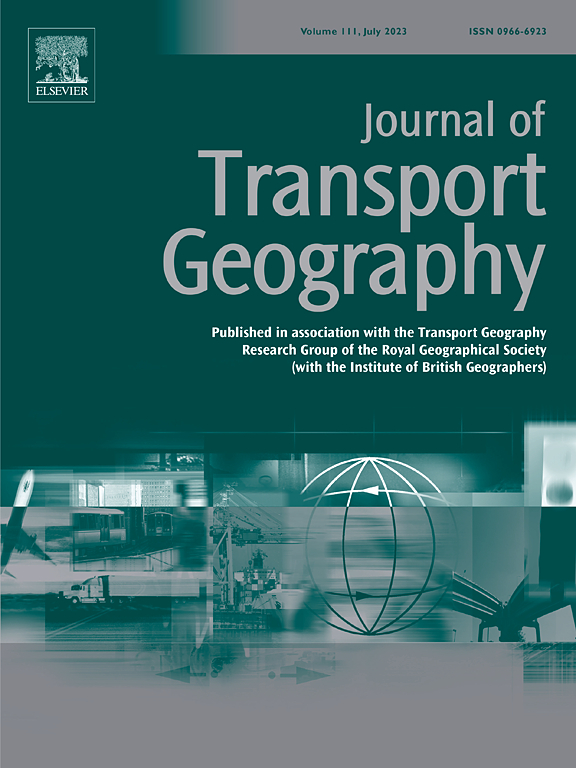2017 年至 2022 年期间美国化石燃料功能区的复杂网络分析
IF 5.7
2区 工程技术
Q1 ECONOMICS
引用次数: 0
摘要
在本文中,我们使用复杂网络分析来描述 2017 年和 2022 年全美 132 个地方之间的化石燃料空间流。这些空间流涉及原油、汽油和石油燃料。分析表明,这三种燃料具有不同的网络拓扑结构。在所有六个网络中,我们发现原油及其产品、汽油和燃油的主要枢纽都集中在美国中南部等储量丰富的地区。利用模块化这一网络集群识别指标,我们发现空间交互作用可用于划分功能区域及其在不同燃料类型之间的差异。随着美国作为化石燃料主要生产国和净出口国的角色转变、国内管道网络的扩张以及燃料生产和提炼地点的增加,这些功能区也在随时间不断演变。本文研究的燃料模式划分显示,管道在原油运输中占据主导地位,2017 年约占运输吨位的 83%,2022 年将增至近 89%。相比之下,汽油和石油燃料的运输方式中,油罐车运输吨位占 60% 左右,其次是包括管道在内的其他运输方式。我们的分析显示,德克萨斯州和路易斯安那州墨西哥湾沿岸的主要枢纽及其功能区在地理上呈集群状分布。这些地方往往是自然灾害的多发地。这种情况加上少数几个枢纽作为美国化石燃料出口门户的迅速增加,使它们成为破坏全球化石燃料供应链的主要候选者,并加剧了化石燃料供应链的脆弱性。本文显示的空间集群趋势为伊利诺伊州芝加哥和得克萨斯州科珀斯克里斯蒂等地的短期负面影响来源提供了更多证据。这为政府干预提供了更多信息。本文章由计算机程序翻译,如有差异,请以英文原文为准。
Complex network analysis of fossil fuel functional regions in the United States during the period 2017 to 2022
In this paper we use complex network analysis to describe fossil fuel spatial flows among 132 places covering the entire United States in 2017 and in 2022. These spatial flows are for crude petroleum, gasoline, and oil fuels. The analysis shows that all three fuels have different network topology. For all six networks we find major hubs of crude petroleum and its products, gasoline and fuel oils, concentrated in areas with large reserves such as the south-central part of the US. Using modularity, a network cluster identification metric, we show that spatial interactions can be used to delineate functional regions and their differences across fuel types. These functional regions evolve over time in response to the shifting US role as a major producer and net exporter of fossil fuels, expansion of the domestic pipeline network, and increases in fuel production and refinement locations. The modal split of the fuels examined in this paper shows the dominant role pipelines play for crude petroleum, transporting approximately 83 % of tonnage in 2017 and increasing to almost 89 % in 2022. In contrast, gasoline and oil fuels modal split hovers at around 60 % of tonnage transported by tanker truck followed by other modes including pipelines. Our analysis shows geographic clustering of major hubs and their functional regions along the Gulf Coast in Texas and Louisiana. These are in places that are often the locations of natural disasters. This together with the rapid increase of a few hubs as gateways to fossil fuel US exports makes them prime candidates in disrupting fossil fuel supply chains worldwide and amplifies vulnerability of fossil fuel supply chains. The spatial clustering trends shown in this paper provide added evidence of the source of short-term negative impacts in places such as Chicago in Illinois and Corpus Christi in Texas. This offers added information for government intervention.
求助全文
通过发布文献求助,成功后即可免费获取论文全文。
去求助
来源期刊

Journal of Transport Geography
Multiple-
CiteScore
11.50
自引率
11.50%
发文量
197
期刊介绍:
A major resurgence has occurred in transport geography in the wake of political and policy changes, huge transport infrastructure projects and responses to urban traffic congestion. The Journal of Transport Geography provides a central focus for developments in this rapidly expanding sub-discipline.
 求助内容:
求助内容: 应助结果提醒方式:
应助结果提醒方式:


